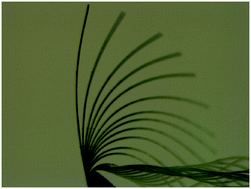Photomechanical response of sulfonylhydrazone molecular crystals†
Abstract
Sulfonylhydrazones are a novel hydrazone-based organic molecular photoswitch. The four derivatives with unsubstituted and o-, m- and p-nitro substituted sulfonylhydrazone (SH-1, SH-2, SH-3, and SH-4, respectively) derived from p-toluenesulfonyl hydrazide and corresponding benzaldehydes were examined with respect to their solution state photoswitching and photomechanical response in the crystalline state. All the compounds displayed UV-induced E → Z isomerization in the solution state, whereas the back conversion was slow. Single crystals of SH-3 displayed rapid and large photomechanical bending, whereas SH-1 and SH-4 crystals underwent slow bending to a comparatively lesser extent. On the contrary, SH-2 crystals did not show any photomechanical effects. The photomechanical deflection of the crystal tip of SH-1 increased linearly; for SH-3, the deflection increased in a sub-linear manner for few seconds, after which it started to revert towards the light source. For SH-4 crystals, the photo-induced tip deflection initially increased in a sub-linear fashion, after which no motion was observed even after continuous exposure to UV light irradiation. The photomechanical behavior of the crystals was also inspected with the aid of velocity-time and acceleration-time plots that unravelled the instantaneous photomechanical motion at various time intervals.

- This article is part of the themed collections: Introducing the CrystEngComm Advisory Board and their research and Crystal Engineering Techniques


 Please wait while we load your content...
Please wait while we load your content...